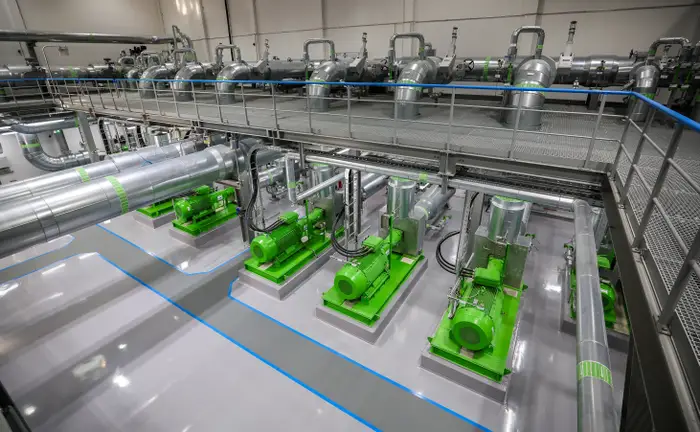Hydrogen has long been hailed as the “fuel of the future” due to its clean-burning properties, emitting only heat and water when combusted. However, traditional methods of hydrogen production, relying on gas or coal, contribute significantly to CO2 emissions. The emergence of ‘green’ hydrogen, produced using renewable energy, has offered a promising but expensive alternative. Recently, a new player has entered the scene – ‘white’ hydrogen. This article delves into the concept of white hydrogen, its potential as a clean energy source, and the challenges it may pose.
Unearthing Natural Hydrogen: What is White Hydrogen?
Hydrogen, the most abundant chemical element on Earth, exists naturally in various forms. Until recently, pure hydrogen gas was not thought to be present in significant quantities within the Earth. The accidental discovery of almost pure natural hydrogen in Mali in 2012 sparked interest in exploring its potential as a clean energy source. Geologists have since been experimenting with extracting this ‘white’ hydrogen, believed to form through water-mineral reactions beneath the Earth’s surface. Unlike fossil fuel stores that take millions of years to form, white hydrogen is continuously replenished.
Is White Hydrogen the Answer to Clean Energy?
The potential of white hydrogen as a clean, cheap, and renewable energy source is under exploration by startups and scientists. Dr. Michael Webber, a professor in energy resources at the University of Texas, Austin, highlights the promising aspect of letting the Earth naturally produce and accumulate hydrogen. White hydrogen, if harnessed efficiently, could offer a cleaner production method compared to current practices involving coal gasification, methane reforming, or water electrolysis.
While most natural hydrogen is expected to be found in offshore locations, deposits have been discovered in various regions, including Australia, eastern Europe, France, Oman, Spain, the US, and Mali. Notably, a substantial deposit in the Lorraine region of France and another in northeast Spain show promise as cost-effective alternatives to traditional green hydrogen.
The Price Tag and Promise
One of the key attractions of white hydrogen is its cost-effectiveness. While green hydrogen currently costs around €5 per kilogram, white hydrogen comes in at just €0.50 per kilogram, making it a financially viable option for large-scale energy production, as reported by Science.
Challenges and Concerns
White hydrogen, though promising, is not without its challenges. The lack of data on hydrogen leaks and their potential environmental impact is a significant concern. Hydrogen, if leaked into the atmosphere, can reduce the concentration of molecules that counteract greenhouse gases, offsetting its environmental benefits. Monitoring and mitigating these leaks pose a considerable challenge due to the absence of robust technology.
Transporting hydrogen presents additional hurdles. In its gaseous form, hydrogen requires a substantial amount of space and must be liquefied at a temperature of -253°C, incurring potentially prohibitive costs. Moreover, the lack of pipelines and distribution systems for hydrogen complicates its widespread adoption. While the fossil fuel industry envisions leveraging existing infrastructure, scientists warn of the corrosive nature of hydrogen, which can pose risks to metal pipes and lead to cracking.
Safety concerns also arise from the explosive nature of hydrogen, which is smaller and lighter than methane molecules. Heat pumps and battery-powered electric vehicles have gained favor over hydrogen-based alternatives due to these safety considerations.
The Geographical Tapestry: White Hydrogen Deposits Across the Globe
The global map of white hydrogen deposits continues to expand, with discoveries in Australia, eastern Europe, France, Oman, Spain, the United States, and Mali. The accidental find in the Lorraine region of France, estimated to contain approximately 46 million tonnes of natural hydrogen, showcases the scale of potential resources waiting to be tapped. Similarly, Helios Aragón’s discovery of over one million tonnes in northeast Spain signals that white hydrogen may not be limited to a single geological locale. The distribution of these deposits prompts further exploration and underscores the need for international collaboration to harness this natural resource efficiently.
Economic Considerations: White Hydrogen’s Cost-Effective Edge
One of the compelling aspects of white hydrogen is its cost-effectiveness, offering a potential solution to the financial hurdles associated with green hydrogen production. With green hydrogen priced at around €5 per kilogram, the substantially lower cost of white hydrogen at €0.50 per kilogram presents a strong economic incentive. As the energy industry seeks sustainable alternatives without compromising financial viability, white hydrogen emerges as an attractive option. The economic feasibility of large-scale production and integration into existing energy infrastructure will likely shape its role in Europe’s energy transition.
Niche Applications: A Future for White Hydrogen?
Despite the challenges, white hydrogen could find its niche in applications where alternatives are limited. Heavy-duty vehicles, such as trucks, ships, and planes that face challenges with battery usage could benefit from white hydrogen. Industries like steel manufacturing and chemical processes, including fertilizer production, may also find white hydrogen more suitable than other clean energy alternatives.
Conclusion
As Europe seeks solutions to its energy crisis, the emergence of white hydrogen raises intriguing possibilities. While the promise of a clean, cheap, and renewable energy source is enticing, the challenges of hydrogen leaks, transportation, and safety concerns cannot be ignored. Whether white hydrogen becomes a mainstream solution or serves specific niche applications remains to be seen. As the exploration continues, it is clear that the quest for a sustainable energy future is driving innovation and pushing the boundaries of our understanding of natural hydrogen.

